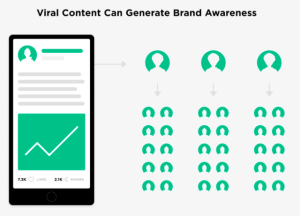Digital Experience Platform
Definition
A Digital Experience Platform (DXP) is a software solution that enables businesses to deliver a seamless, personalised digital experience across multiple channels and touchpoints.
Description
A digital experience platform is a powerful tool for businesses that want to create a cohesive, personalised digital experience for their customers. By combining a range of tools and capabilities into a single platform, a DXP can help businesses manage their digital content, data, and interactions more effectively, ultimately improving customer engagement and driving business growth.
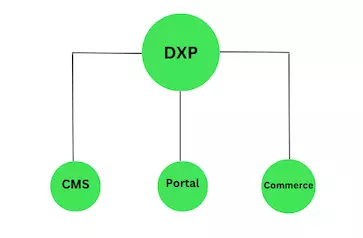
Brands can create and manage a seamless, personalised digital experience for their customers across multiple channels and touchpoints regardless of how they interact with a company’s digital presence.
Importance of Digital Experience Platform
Digital experience platforms (DXPs) are becoming increasingly crucial for businesses in today’s digital age. Here are some of the key reasons why:
- Improved customer engagement: DXPs enable businesses to deliver customers a seamless, personalised digital experience across multiple channels and touchpoints. By providing a cohesive and consistent experience, businesses can improve customer engagement and satisfaction, increasing customer loyalty and retention.
- Increased efficiency: By combining various tools and capabilities into a single platform, DXPs enable businesses to manage their digital content, data, and interactions more efficiently. This can lead to cost savings and increased productivity, as companies can streamline their digital operations and reduce the need for multiple tools and systems.
- Data-driven insights: DXPs typically include analytics and personalization tools that enable businesses to analyse customer behaviour and preferences and personalise the customer experience based on this data. Businesses can optimise their marketing and sales strategies by leveraging data-driven insights and improving customer engagement and conversion rates.
- Agility and flexibility: DXPs enable businesses to quickly adapt to changing customer needs and market conditions. By providing a flexible and agile platform for managing digital content and interactions, businesses can respond more rapidly to new opportunities and challenges and stay ahead of the competition.
- Improved brand reputation: By providing a seamless and personalised digital experience, businesses can improve their brand reputation and standing in the market. This can increase customer loyalty and positive word-of-mouth and enhance business performance.
What are the components of Digital Experience Platform?
A DXP typically includes various tools and features that help businesses manage digital content, data, and customer interactions. Some of the critical components of a DXP include:
- Content management system (CMS): A CMS enables businesses to create and manage digital content, such as web pages, blogs, and product descriptions, in a centralised location.
- Customer relationship management (CRM) system: A CRM system helps businesses manage customer interactions, including customer data, sales leads, and customer support requests.
- Analytics and personalization tools: DXPs typically include tools for analysing customer behaviour and preferences and personalising the customer experience based on this data.
- Marketing automation: A DXP may also include tools for automating marketing tasks, such as email campaigns and social media posts.
- E-commerce capabilities: Many DXPs include features for managing online sales and transactions, such as shopping carts and payment processing.
How does a digital experience platform work?
A digital experience platform (DXP) works by bringing together a range of tools and capabilities into a single platform that enables businesses to create and manage a seamless, personalised digital experience for their customers across multiple channels and touchpoints.
At its core, a DXP typically includes a content management system (CMS) that enables businesses to create and manage digital content, such as web pages, blogs, and product descriptions, in a centralised location. This content can be quickly published across multiple channels, such as websites, mobile apps, social media, and other digital touchpoints.
In addition to the CMS, a DXP typically includes a range of other tools and features that help businesses manage their digital interactions with customers. These may include:
- Customer relationship management (CRM) system: A CRM system helps businesses manage customer interactions, including customer data, sales leads, and customer support requests.
- Analytics and personalization tools: DXPs typically include tools for analysing customer behaviour and preferences and personalising the customer experience based on this data.
- Marketing automation: A DXP may also include tools for automating marketing tasks, such as email campaigns and social media posts.
- E-commerce capabilities: Many DXPs include features for managing online sales and transactions, such as shopping carts and payment processing.
By bringing together all of these tools and capabilities into a single platform, a DXP enables businesses to manage their digital content, data, and interactions more efficiently and effectively. This can lead to improved customer engagement, efficiency, data-driven insights, agility and flexibility, and brand reputation.
A DXP is a powerful tool for businesses that want to create a cohesive, personalised digital experience for their customers across all digital touchpoints. Businesses can improve customer engagement and drive business growth over time by providing a centralised platform for managing all aspects of the digital customer experience.
Future Scope Of Digital Experience Platform
The future scope of Digital Experience Platforms (DXPs) is quite promising as businesses increasingly shift towards digital transformation. DXPs are becoming more critical for companies to enhance customer experiences, improve business processes, and drive growth.
Some of the future trends in DXPs are:
- Personalization: Customers demand personalised experiences, and DXPs enable businesses to deliver that by using data analytics and artificial intelligence to provide tailored content and recommendations.
- Omnichannel support: With customers interacting with businesses through multiple channels, DXPs must offer seamless integration across all touchpoints, from websites to social media platforms and mobile apps.
- Integration with emerging technologies: As emerging technologies such as the Internet of Things (IoT) and Augmented Reality (AR) become more prevalent, DXPs will need to integrate with these technologies to offer an immersive experience to customers.
- Security: Cybersecurity threats are a constant concern, and DXPs must offer robust security measures to protect customer data and prevent breaches.
- Low-code/no-code development: DXPs will increasingly offer low-code or no-code development options, allowing businesses to build custom digital experiences without extensive coding knowledge.
Example:
Salesforce offers a DXP that combines customer data, analytics, and content management to deliver personalised experiences across all touchpoints.
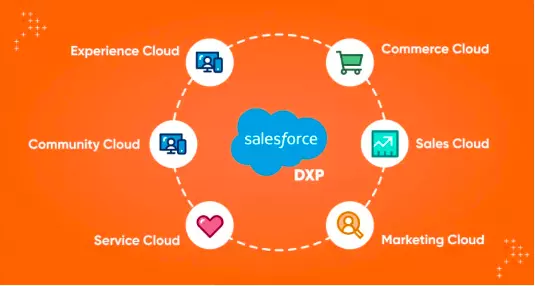
Source: https://www.axelerant.com/
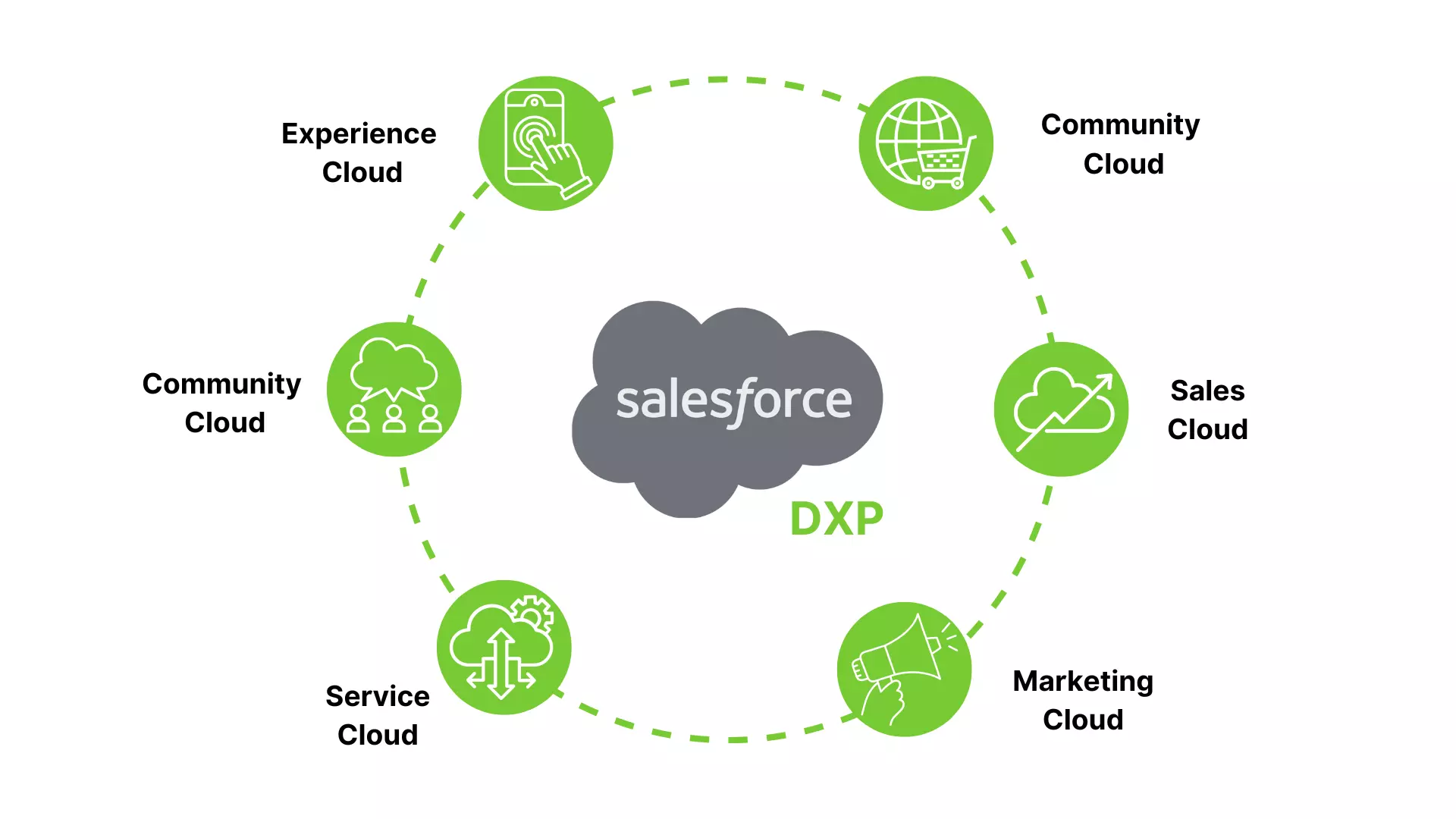
It provides a comprehensive suite of tools for managing customer data, creating personalised experiences, and delivering content across multiple channels. With Salesforce’s DXP, businesses can build and customise digital experiences tailored to their customer’s needs and preferences.
The platform’s robust analytics capabilities enable enterprises to gain insights into their customers’ behaviour and preferences, allowing them to create targeted marketing campaigns and personalised experiences. The DXP tool is highly scalable and can accommodate businesses of all sizes, making it an ideal choice for enterprises looking to transform their digital presence. Salesforce’s DXP is a powerful tool that helps businesses enhance customer experiences and drive growth.
FAQs
What is a Digital Experience Platform (DXP)?
A Digital Experience Platform (DXP) is a software platform that combines content management, customer data management, and other digital experience tools to deliver personalised and engaging customer experiences across multiple channels.
What are the benefits of a DXP?
DXPs offer several benefits, including the ability to deliver personalised experiences, improve customer engagement and satisfaction, streamline business processes, and drive growth and revenue.
What features are included in a DXP?
Features in a DXP may vary but typically include content management, personalization tools, analytics and reporting, customer data management, social media integration, and marketing automation.
How do DXPs differ from traditional content management systems (CMS)?
While DXPs and CMSs manage digital content, DXPs offer a broader range of capabilities beyond content management, including personalization, customer data management, and marketing automation.
What types of businesses can benefit from a DXP?
DXPs can benefit businesses of all sizes and industries but are particularly useful for enterprises looking to enhance their digital presence and improve customer experiences across multiple channels.
Agency Balanced Scorecard
Definition
The agency-balanced scorecard is a performance management tool that measures and tracks an organisation’s strategic objectives across four perspectives: financial, customer, internal processes, and learning and growth.
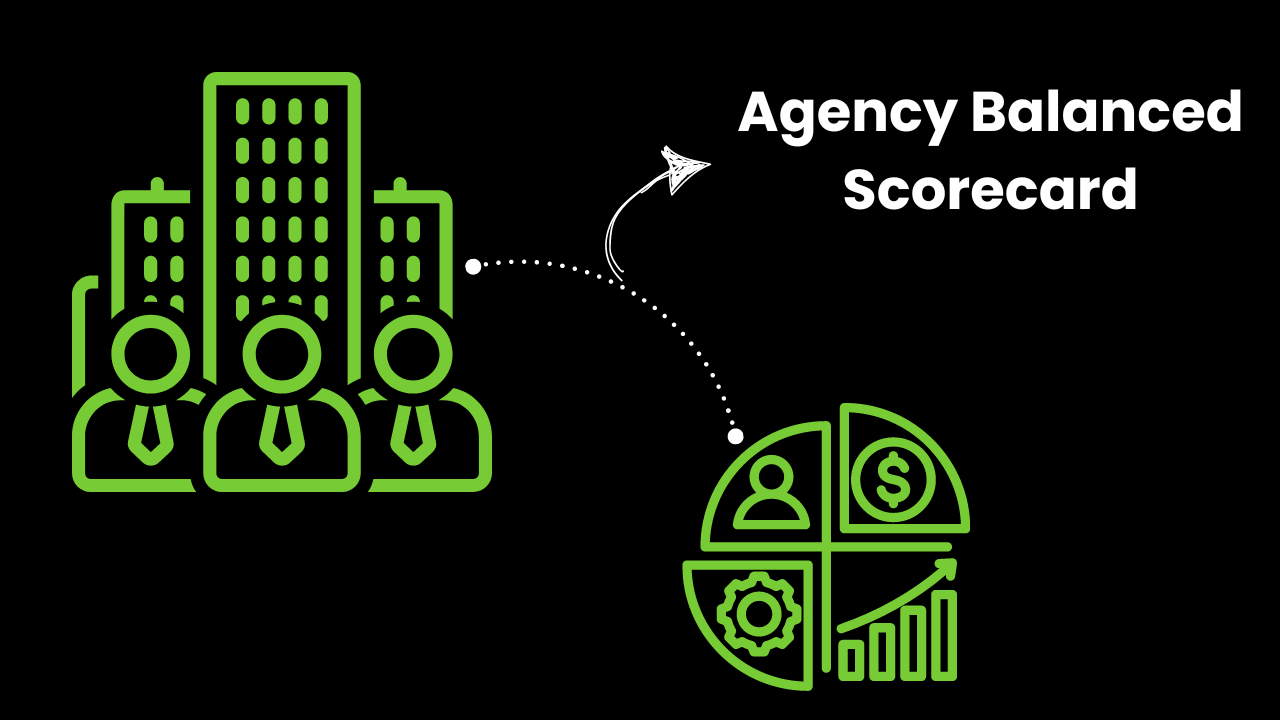
Description
The agency-balanced scorecard is a performance management framework that helps organisations to translate their strategic objectives into measurable and actionable goals across four perspectives: financial, customer, internal processes, and learning and growth.
Each perspective has a set of key performance indicators (KPIs) aligned with the organisation’s overall strategy. These KPIs are used to track and monitor progress towards achieving strategic objectives and identify improvement areas.
The agency-balanced scorecard provides a holistic view of organisational performance, allowing managers to make informed decisions based on financial and non-financial data. By focusing on both short-term and long-term objectives, the balanced scorecard helps organisations balance their performance across different areas and to achieve sustainable growth.
Importance of Agency Balanced Score
An agency-balanced scorecard is essential for organisations because it provides a comprehensive view of performance across multiple dimensions. Some key benefits of using the balanced scorecard include the following:
- Strategy alignment: The balanced scorecard helps organisations align their strategic objectives with their operational activities. By focusing on a few key performance indicators in each perspective, the organisation can ensure everyone is working towards the same goals.
- Improved communication: The balanced scorecard helps to enhance communication and understanding of the organisation’s strategy and objectives. By providing a clear and concise framework for tracking performance, managers can communicate progress to stakeholders more effectively.
- Better decision-making: The balanced scorecard gives managers a complete picture of organisational performance. By considering both financial and non-financial data, managers can make more informed decisions and take action to improve performance in areas that need attention.
- Continuous improvement: A balanced scorecard is a tool for continuous improvement, allowing organisations to track progress over time and identify areas for improvement. By regularly reviewing performance data, managers can adjust operations and processes to improve overall performance.
How to develop an Agency Balanced Scorecard?
Developing an agency-balanced scorecard involves several steps:
- Define the organisation’s strategic objectives:
The first step is to define the organisation’s strategic objectives. This may involve reviewing the organisation’s mission and vision statements and identifying key priorities and goals. - Determine the perspectives:
The next step is determining the perspectives included in the balanced scorecard. The four main perspectives are financial, customer, internal processes, and learning and growth. Considering which views are most relevant to the organisation’s goals and objectives is essential. - Identify key performance indicators (KPIs):
For each perspective, identify the KPIs that will be used to measure performance. KPIs should be specific, measurable, relevant, and aligned with the organisation’s strategic objectives. - Set targets:
Once the KPIs have been identified, set targets for each. These targets should be challenging but achievable and aligned with the organisation’s strategic objectives. - Develop action plans:
Develop action plans to achieve the targets for each KPI. These action plans should identify specific initiatives and activities that will be undertaken to improve performance. - Monitor and review performance:
Once the balanced scorecard has been implemented, it’s essential to regularly monitor and review performance. This involves tracking progress towards achieving the targets, identifying improvement areas, and making necessary adjustments to the action plans. - Communicate results:
Finally, it’s essential to communicate the results of the balanced scorecard to stakeholders. This helps to promote transparency and accountability and can help to build support for the organisation’s strategic objectives.
What are the 7 elements of the Agency Balanced Scorecard?
The agency-balanced scorecard typically consists of seven main elements:
- Vision and Strategy outline the organisation’s vision, mission, and strategic objectives.
- Perspectives: The balanced scorecard includes four perspectives: financial, customer, internal processes, and learning and growth. These perspectives help ensure that the organisation is measuring performance across various dimensions.
- Objectives: Each perspective includes a set of goals aligned with the organisation’s overall strategic objectives.
- Key Performance Indicators (KPIs): A set of KPIs is identified to measure performance for each objective.
- Targets: Targets are set for each KPI to provide a benchmark for measuring progress.
- Initiatives: Action plans or initiatives are developed to help achieve the targets.
- Monitoring and Reporting: Performance is monitored and reported regularly to assess progress and identify areas for improvement.
Future prospects in Agency Balanced Scorecard
The future prospects for the agency’s balanced scorecard are promising. As organisations continue to face increasing pressure to achieve their strategic objectives, the balanced scorecard provides a valuable tool for managing performance and aligning activities with the organisation’s overall strategy.
One potential future prospect is integrating technology into the balanced scorecard framework. This could involve using data analytics and visualisation tools to better track and monitor performance and to identify patterns and trends that may not be immediately apparent.
Another future prospect is the continued evolution of the balanced scorecard framework to incorporate new perspectives or metrics relevant to changing business environments. For example, as sustainability and environmental considerations become increasingly important for organisations, a greater focus may be on developing KPIs that measure environmental impact and sustainability performance.
Finally, the agency-balanced scorecard may evolve in response to changing organisational structures and management practices. As organisations become more decentralised and rely more on cross-functional teams, the balanced scorecard may need to be adapted to ensure that performance is managed appropriately.
Example:
A brand that has implemented an agency-balanced scorecard is Coca-Cola. The company’s balanced scorecard includes four perspectives: financial, customer, internal processes, and learning and growth.
From the financial perspective, Coca-Cola measures performance based on revenue growth and return on investment. The company tracks customer satisfaction and loyalty metrics, such as customer retention and net promoter score for the customer perspective.
The brand measures performance related to critical business processes such as production efficiency and supply chain management from the internal processes perspective. Under the learning and growth perspective, the company focuses on areas such as employee training and development, innovation, and new product development.
Coca-Cola’s balanced scorecard has helped the company align its activities with its overall strategic objectives and ensure that performance is managed effectively across various dimensions.
By regularly monitoring and reviewing performance using the balanced scorecard, Coca-Cola can identify areas for improvement and make data-driven decisions to improve its overall performance.
FAQs
What is an agency-balanced scorecard?
An agency-balanced scorecard is a strategic management tool that provides a framework for measuring and managing organisational performance across various dimensions.
What are the main benefits of using an agency-balanced scorecard?
The main advantages of using an agency-balanced scorecard include improved alignment of activities with strategic objectives, better communication and transparency, and a more holistic approach to performance management.
What are the four main perspectives included in the agency-balanced scorecard?
The four main perspectives are financial, customer, internal processes, and learning and growth.
What are key performance indicators (KPIs) in the agency-balanced scorecard?
KPIs are specific metrics used to measure performance within each balanced scorecard perspective.
How can an agency-balanced scorecard be developed?
Developing an agency-balanced scorecard involves several steps, including defining the organisation’s strategic objectives, determining the relevant perspectives, identifying KPIs, setting targets, developing action plans, monitoring and reviewing performance, and communicating results.
What are some future prospects for the agency’s balanced scorecard?
Future prospects for the agency’s balanced scorecard include integrating technology, incorporating new perspectives or metrics, and adapting to changing organisational structures and management practices.
Also Read –
Affiliate Merchant
Definition
Affiliate merchant refers to the individual who taps the affiliate network to increase sales and brand awareness of their products and services.
Description
An affiliate merchant, also known as an advertiser or vendor, is a business that offers an affiliate program to promote its products or services. Affiliate merchants partner with affiliates who promote their products or services to their audience in exchange for a commission on any resulting sales or leads.
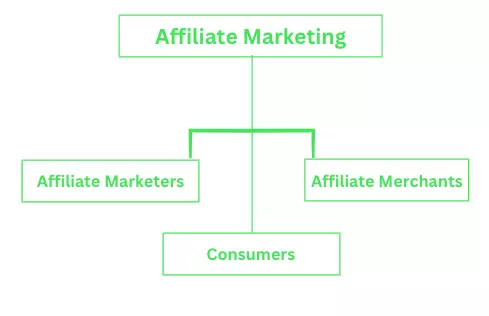
A business must establish an affiliate program to become an affiliate merchant. This involves creating a commission structure, developing marketing materials and tracking links, and setting up a system to track and pay commissions to affiliates.
Once the affiliate program is established, the merchant can recruit affiliates to promote their products or services. This is done through various channels, such as affiliate networks, social media, and email marketing.
The merchant provides their affiliates with promotional materials, such as banners, text links, and product information, for their promotions. The fellow then promotes the merchant’s products or services to their audience using the provided materials and tracking links.
When a customer clicks on an affiliate’s tracking link and makes a purchase, the merchant pays a commission to the affiliate based on the agreed-upon commission structure. The affiliate merchant benefits by reaching a wider audience and generating more sales or leads, while the affiliate earns a commission for promoting the merchant’s products or services.
Importance of Affiliate Marketing
Affiliate merchants are important for several reasons:
- Increased Sales: By partnering with affiliates, merchants can tap into the promotional efforts of these partners to reach new audiences and increase sales.
- Cost-Effective Marketing: Affiliate marketing is a cost-effective way for merchants to promote their products or services because they only pay commissions when sales or leads are generated.
- Brand Exposure: Affiliate marketing can help merchants increase their brand exposure by getting their products or services in front of new audiences through the promotional efforts of their affiliates.
- Diversification: Affiliate marketing allows merchants to diversify their marketing efforts by leveraging their affiliates’ audiences and promotional channels.
- Performance Tracking: Merchants can track their affiliate program’s performance and measure their campaigns’ success, identify improvement areas, and optimise their strategies to maximise sales and revenue.
- Scalability: Affiliate marketing is a scalable marketing channel that can help merchants grow their business by tapping into their affiliates’ audiences and promotional efforts.
How to start with Affiliate Marketing as an Affiliate Merchant?
Here are the steps to follow to start with affiliate marketing as a merchant:
- Determine your niche: Identify your target market and the niche that your products or services serve. This will help you identify the types of affiliates you should recruit and create content that resonates with your target audience.
- Choose an affiliate network: Select one that fits your needs and budget. Some popular affiliate networks include ShareASale, CJ Affiliate, and Amazon Associates.
- Create an affiliate program: Create an affiliate program that offers competitive commission rates and includes all the necessary details, such as the commission structure, marketing materials, and payment terms.
- Recruit affiliates: Reach out to potential affiliates through your network or social media platforms. Consider offering incentives for joining your program, such as a sign-up bonus or higher commission rates.
- Provide marketing materials: Create marketing materials, such as banners, text links, and product information, for your affiliates to use in their promotions.
- Track and monitor performance: Use tracking tools to monitor your affiliate program’s performance and identify areas for improvement. Provide regular updates to your affiliates on their progress and commission earnings.
- Optimise your program: Use the insights gained from tracking and monitoring to optimise your affiliate program, such as adjusting commission rates, refining marketing materials, or recruiting new affiliates.
Example:
Let’s say that Company A sells athletic shoes online, and they want to increase their sales. So they decide to launch an affiliate program, where affiliates can earn a commission for referring customers to their website.
Company A partners with several affiliates, including a famous fitness blogger. The blogger reviews the shoes on their website, including a link to Company A’s website. The blogger earns a commission when a reader clicks on the link and purchases from Company A.
Company A provides each affiliate with a unique tracking link to track referrals and commissions. When a customer clicks on an affiliate’s tracking link and purchases, the affiliate’s commission is automatically calculated and paid out.
This benefits both Company A and its affiliates. Company A gets more exposure and sales, while the affiliates earn a commission for promoting products they believe in. It’s a win-win situation!
FAQs
Can affiliates promote merchants?
Yes, affiliates can promote merchants.
How do affiliates promote merchants?
The affiliates can use these strategies to promote merchants:
- Content and niche sites
- Email lists
- Coupon and promotion sites
- Personal websites
Affiliates can promote the merchants by using any means to showcase their products on social media networks.
Is there a limit to promote merchants across the industry?
No, there is no limit to promoting merchants across the industry. They can promote as many merchants as they want and use the best of the techniques they want.
What is the job of an affiliate merchant?
An affiliate merchant leverages an affiliate network to increase sales of a brand. It helps the brands to increase brand awareness which in turn drives more profits.
Also Read – What Is Affiliate Marketing? Everything You Need to Know in 2024
Word-of-Mouth
Word-of-Mouth
Definition
Word-of-Mouth is when a consumer’s liking in a company’s products or services is reflected in their daily dialogue.
Description
Promoting a brand is important for the company’s sales and revenue generation. Companies spend lakhs of rupees in advertising and marketing. One free form of advertising that can loop in more target audience and contribute to increase the sales of the brand is called word of mouth marketing.
Word-of-mouth marketing is completely triggered by how the customers feel after consuming your product or services. And after they feel satisfied with the company’s services or products, if the users recommend it to several other friends or family it becomes word of mouth marketing.
82% of marketers use it to increase brand awareness whereas 43% of marketers wish to improve their direct sales. It includes various techniques that include writing blog posts or content for social media marketing.
Importance of Word of Mouth Marketing
Word of mouth marketing is important for brands as it:
- Attracts target audience to trust their product and services.
- Contributes to the increase in sales and revenue of the brand.
- Strengthens the brand authority and likelihood of people buying the product and services increases.
- Assists brands to gain popularity ultimately leading to higher revenue generation.
How does word of mouth marketing work?
The basic idea behind marketing is to promote products and services and when you talk about it, it is the marketing done verbally. There are different ways in which you can choose word-of-mouth marketing.
Traditional Word of Mouth Marketing
Reading through the billboards that display ads of a brand becomes word of mouth marketing.

Online Word of Mouth Marketing
As the number of online users have increased manifold, it is important for brands to take a chance around online marketing. Some of the ways in which brands can do it include:
- Blogs: Start writing a blog as it can be a wonderful way of expressing one’s opinion about a brand. It can help companies to connect fast with the target audience.
- Leave reviews on the sites: Reviews and feedback influence the audience purchase decision. Companies can include the section on their website to boost their brand authority and awareness.
- Social media sites: Social media platforms give immense opportunities to share experience, photos, and links. It is a popular way for word-of-mouth publicity as people consider the opinions and experience of others before making a decision.
For social media and online you can practise this:
- Create buzzworthy content
- Provide excellent experience
- Empower fans and experts
- Become a thought leader
- Collect online reviews
Key insights on Word of Mouth Marketing
These are the key insights on this marketing
- 88% of consumers trust that online reviews written by consumers are considered as recommendations by people other than friends and family.
- HubSpot research shows that 75% of consumers do not believe in adverts and 90% trust in suggestions from family and friends.
- 60% of millennials are more inclined to take advice from YouTube influencers than other media personalities.
- 41% of customers discover new products through influencers weekly.
- 74% consumers identify it as a key influencer in their purchasing decision.
- 46% of small businesses choose softwares based on colleagues recommendations and other companies in industry.
- 20% of businesses plan to use this marketing in their yearly marketing strategy.
- 28% of people say that it increases brand affinity.
- Millennials are 38% more likely to discover brands through recommendations from family and friends
- 70% of marketers are looking to increase their online word of mouth spending.
Example
Netflix is one of the best examples that worked wonders and multiplied its users with word-of-mouth marketing. The OTT platform offers an enjoyable and original experience. Netflix enhances the user’s experience by tapping into the user’s data and sentiments. The platform recommends favourite movies and shows that the user would like to watch.
FAQs
Is Word of Mouth marketing good for marketing?
Yes, this marketing is considered good for marketing. It is the free form of marketing.
What are the digital forms of Word of Mouth marketing?
Some of the best marketing forms for digital platforms include review boards, blogs and social media sites.
Ways in which you can encourage word of mouth marketing?
These are the ways in which you can encourage this marketing:
- Refer-a-friend program: Referring friend to shop, stay or travel, availing some benefit because of you, it becomes a refer-a-friend program. This becomes a win-win offer for both.
- Work with influencers: Working with influencers for brands can be easily captured by the audience. It is like getting more audience just because an influencer is using a product and hence making a suggestion.
- Give-aways: Giveaway posts are personal recommendations for the audience to buy the product or services. It is like engaging higher with a post and then sending some giveaway for the audience.
- Ask customers for ratings: Best way to increase your credibility and gain fame through word of mouth is asking friends for recommendations.
- Use hashtags: Hashtags are the keywords that help the audience find your brand organically. Also using hashtags update the followers.
What are the four types of word-of-mouth marketing?
These are the four types of word-of-mouth marketing:
- Buzz marketing: Many companies and brands choose for buzz marketing especially when they launch new products or services. In the most common way, they create a buzz by making a waiting list or sharing teasers like Wednesday Sale.
- Content marketing:Creating content that engages the audience for long is important considering the audience type. The brands can present valuable information in an entertaining way. They can create content in the form of blogs, podcasts, videos, and infographics. Brands can make their impression by developing content with a perspective that everyone misses, ask questions, or the one that are go-to guides.
- Referral marketing: Referral marketing is about hiring people to promote your business and in turn earn a commission. One example can be affiliate marketing where affiliates promote your products in blogs, articles, videos, and eBooks.
- Social media marketing: brands can promote their products and services through social media marketing. But because there are millions of users and sellers, it gets difficult to outshine. Hence, brands must maintain consistency in content update to engage the audience for a longer time. Build relationships and then loop in customers.
Website
Definition
A website is a collection of web pages linked together and accessible over the internet through a web browser.
Description
Displaying your product and services to a wider audience is convenient through a website. It is a destination that provides detailed information to the visitors. If the information available is interesting, it can engage the readers for a longer time encouraging them to take some action like clicking on the link, leaving email id, etc.
Individuals, organisations, or businesses typically create it to provide information, services, or products to a global audience. It can vary in size, complexity, and functionality, ranging from simple personal blogs to complex e-commerce platforms. It can also be static, meaning their content stays mostly the same, or dynamic, meaning their content is frequently updated and interactive.
Overall, websites are a powerful tool for communication, education, entertainment, and commerce in the modern digital age.
Importance of Website
These are significant for individuals, organisations, and businesses in the digital age for several reasons:
- Establishing an Online Presence: It is a powerful tool for establishing an online presence, allowing individuals and businesses to showcase their products, services, skills, and expertise to a global audience. It is a way to make a solid first impression and establish credibility in the digital world.
- Accessibility and Convenience: These are available 24/7, allowing users to access information, products, and services anytime from anywhere in the world. This level of accessibility and convenience is unparalleled, making websites a must-have for businesses and organisations that want to cater to a global audience.
- Marketing and Advertising: It effectively market and advertise products and services to a large audience. They can be optimised for search engines, making them visible to potential customers searching for specific products and services.
- Communication and Engagement: It can be used to communicate and engage with customers, clients, and stakeholders. They can provide information, answer questions, collect feedback, and build a community around a brand or product.
- E-commerce and Online Sales: It can be an e-commerce platform, allowing businesses to sell products and services online, process payments, and manage orders. This can significantly increase revenue and reach for companies.
How to make a website for marketing?
To make a website for marketing, here are some critical steps to follow:
- Define your target audience:
Before designing your website, defining your target audience is essential. Understanding your audience’s needs, preferences, and interests can help you create a website tailored to them.
- Choose a domain name and hosting provider:
Your website’s domain name is its address on the internet, so it’s important to choose a name that is easy to remember and relevant to your business or brand. You’ll also need to select a hosting provider where your website will be stored and available online.
- Design your website:
Your website’s design is crucial for attracting and retaining visitors. You can design it using website builders like Wix or WordPress or hire a professional web designer to create a custom design for you. Ensure your website is visually appealing, easy to navigate, and optimised for mobile devices.
- Create valuable content:
Your website’s content is the key to attracting and engaging visitors. Create high-quality, helpful content that resonates with your target audience. Use images, videos, and infographics to make your content more engaging.
- Optimise your website for search engines:
Search engine optimization (SEO) is optimising your website to rank higher in search engine results pages (SERPs). Ensure that it is optimised for relevant keywords, has high-quality backlinks, and has a fast loading speed.
- Incorporate social media:
Social media is a powerful marketing tool that can drive traffic to your website. Incorporate social media buttons and links to encourage visitors to share your content on social media.
- Implement analytics:
Use tools like Google Analytics to track your website’s traffic, user behaviour, and conversion rates. Use this data to optimise your site and improve your marketing efforts.
Benefits of Website
It offer a wide range of benefits to individuals, organisations, and businesses, including:
- Increased visibility:
It provides a platform for individuals and businesses to showcase their products, services, skills, and expertise to a global audience. This can significantly increase their visibility and reach, making connecting with potential customers, clients, and stakeholders easier.
- Enhanced credibility:
It can help establish credibility and build trust with potential customers or clients. It can showcase testimonials, awards, and accomplishments, further enhancing credibility and reputation.
- Accessibility and convenience:
It is available 24/7, providing users convenient access to information, products, and services worldwide. This level of accessibility and comfort is unparalleled, making websites a must-have for businesses and organisations that want to cater to a global audience.
- Marketing and advertising:
It effectively markets and advertises products and services to a large audience. It can be optimised for search engines, making it visible to potential customers searching for specific products and services.
- Communication and engagement:
A website can communicate with customers, clients, and stakeholders. It can provide information, answer questions, collect feedback, and build a community around a brand or product.
- E-commerce and online sales:
It can be an e-commerce platform, allowing businesses to sell products and services online, process payments, and manage orders. This can significantly increase revenue and reach for companies.
- Data collection and analysis:
A website can collect data on user behaviour, preferences, and interests. This data can be analysed to gain insights into customer behaviour and preferences, informing marketing and business decisions.
Future of Website Building
The future of website-making is likely to involve several trends and technologies, including:
- Artificial Intelligence (AI): AI will likely play an increasingly important role in website development, particularly in personalization, chatbots, and search optimization.
- Voice-based interactions: With the increasing popularity of smart speakers and voice assistants, it must be optimised for voice-based interactions, such as voice search and voice commands.
- Mobile-first design: With most internet users accessing websites from mobile devices, it must be designed with a mobile-first approach, optimising for smaller screens and touch-based interactions.
- Augmented Reality (AR): AR will likely be increasingly used on websites to enhance user experiences, particularly in e-commerce, product visualisation, and education.
- Progressive Web Apps (PWAs): PWAs are web applications that behave like native apps, providing an app-like experience within a web browser. PWAs are likely to become more popular as they offer the convenience of a mobile app without downloading or installing it.
- Low-code or no-code development: Low-code or no-code development platforms enable non-technical users to create it and web applications with minimal coding. These platforms will likely become more popular, making it easier for individuals and small businesses to create websites without hiring professional developers.
Tools for Website Development
There are many platforms available to design and build a website. Here are a few examples:
- WordPress:
WordPress is a popular open-source content management system (CMS) that can create various websites, from blogs to e-commerce sites. It offers a range of templates and plugins, making it easy to customise the design and functionality of your site.
- Wix:
Wix is a drag-and-drop website builder offering various templates and design tools to create a customised site. It provides a user-friendly interface that makes it easy to build and edit your website without coding knowledge.
- Squarespace:
Squarespace is a website builder offering various templates and design tools to create a professional-looking site. It provides a range of features, including e-commerce functionality, analytics, and mobile optimization.
- Shopify:
Shopify is a popular e-commerce platform that provides everything you need to set up an online store. It offers a range of customizable templates and features, making creating a professional-looking e-commerce site accessible.
- Joomla:
Joomla is an open-source CMS used to build various websites, from small business sites to large e-commerce sites. It offers a range of templates and extensions to customize the design and functionality.
- Drupal:
Drupal is another open-source CMS used to build various websites, from tiny blogs to large corporate sites. It offers a range of modules and templates to customize the design and functionality.
- Weebly:
Weebly is a drag-and-drop website builder that offers a range of templates and design tools to create a professional-looking website. It provides a user-friendly interface that makes it easy to build and edit your website without coding knowledge.
Example
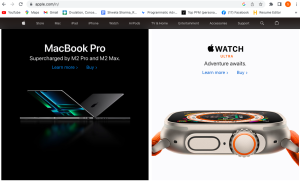
Apple’s website is known for its clean, minimalist design and sleek visuals that showcase its products in a sophisticated and high-end way. It is easy to navigate and offers a seamless user experience that complements the company’s branding.
FAQs
Why do I need a website for my business?
It can establish an online presence, reach a wider audience, and promote your products and services. It can also provide a platform for customer engagement and feedback and help establish your brand and credibility.
How much does it cost to build a website?
The cost of building a website can vary depending on factors such as the design’s complexity, the website’s size, and the features and functionalities required. An essential site can be built for a few hundred dollars, while a more complex one can cost thousands.
How long does it take to build a website?
The time it takes to build a website can vary depending on the design’s complexity, the website’s size, and the availability of content and resources. An essential site can be built in a few days or weeks, while a more complex website can take several months to complete.
What is website hosting?
Website hosting is a service that allows individuals and businesses to make their websites accessible through the internet. Website hosting providers store the files on their servers, making them accessible to users worldwide.
What is website maintenance?
Website maintenance involves keeping the website up to date, ensuring that it is secure and functional, and making regular updates and improvements as needed. This can include updating content, fixing broken links, and updating software and security features.
How can I promote my website?
There are many ways to promote a website, such as using search engine optimization (SEO) to improve visibility in search engines, using social media to drive traffic, and using paid advertising to promote the website to a broader audience.
How can I track website analytics?
Website analytics tools like Google Analytics can track website traffic, user behaviour, and engagement. These tools can provide valuable insights into user preferences and behaviour, which can be used to improve the site and drive better results.
Voice Search
Voice Search
Definition
Voice search refers to using spoken language to search for information on the internet.
Description
Technology has infused convenience in the life of the users. From typing normal search queries to using it for convenience, the dynamics of the search engines have changed.

Rather than typing in keywords on a search engine, users can simply ask a question or make a statement out loud to get search results. It is made possible by voice recognition technology, which converts spoken words into text.
Then it uses natural language processing algorithms to understand the user’s intent and provide relevant search results. It is becoming increasingly popular with the rise of voice assistants such as Amazon Alexa, Google Assistant, and Apple Siri, as well as the integration of it into mobile devices, smart speakers, and other connected devices.
The convenience of it has made it a popular choice for users who are multitasking, driving, or have limited mobility. It has also presented new opportunities for businesses to optimise their online content for voice search to improve their visibility and reach their target audience.
Importance of Voice Search
It has become an essential part of our daily lives, and its importance is growing as more and more people use voice-activated devices and assistants to search for information online. Here are some reasons why it is essential:
- Convenience:
Voice Search is more convenient than typing on a keyboard or mobile device. It allows users to search for information hands-free while driving, cooking, or doing other tasks.
- Accessibility:
It makes the internet more accessible for people with disabilities, such as visual or mobility impairments. It also makes using technology easier for older adults or people with limited mobility.
- Faster and More Accurate Results:
Voice search allows users to get search results quickly and accurately without the need to type in a search query. This is particularly helpful when searching for information on the go, as voice assistants can answer questions instantly.
- Personalization:
Voice assistants can be customised to recognize individual users and their preferences, making the search experience more personalised and tailored to their needs.
- Growing Trend:
It is a growing trend expected to increase in popularity. This means that businesses and marketers need to optimise their content for voice search to stay relevant and reach their target audience.
- SEO Implications:
It has search engine optimization (SEO) implications. Voice searches tend to be longer and more conversational than text-based searches. Businesses must optimise their content for long-tail keywords and natural language to rank higher in search results
Voice Search and Relevance of SEO
It is changing how people search for information online and has implications for search engine optimization (SEO). Here are some ways in which voice search is relevant for SEO:
- Use of Long-tail Keywords: These are longer and more conversational than text-based searches. Businesses must optimise their content for long-tail keywords and natural language to rank higher in voice search results.
- Emphasis on Local Search: It is often used for local searches, such as “near me” or “local coffee shops.” This means businesses need to optimise their content for local search by including location-based keywords, claiming their Google My Business listing, and ensuring their business information is accurate and up-to-date.
- Featured Snippets: Voice assistants often read the featured snippet in response to a voice query. Businesses must optimise their content for featured snippets by providing precise and concise answers to frequently asked questions.
- Mobile Optimization: It is often used on mobile devices, which means that businesses need to ensure their website is mobile-friendly and optimised for fast loading times.
- Natural Language Processing: It relies on natural language processing (NLP) to understand user intent and provide relevant search results. This means businesses need to optimise their content for NLP by using natural language and answering user queries directly.
- Structured Data: Using structured data can help search engines understand the content on your website and provide more relevant search results. This is particularly important for voice search, as it can help voice assistants understand the context of your content and provide more accurate responses.
How to add voice search on your website?
Adding it to your website can significantly improve the user experience and increase engagement. Here are the steps to add voice search to your website:
- Choose a Voice Search Plugin or API:
Many plugins and APIs are available for it, such as Google Speech Recognition API, Mozilla Web Speech API, and Wit.ai. Choose one that best fits your website’s needs and technical requirements.
- Install the Plugin or API:
Once you have chosen a suitable plugin or API, follow the installation instructions provided by the developer. This may involve adding code to your website or installing a plugin or widget.
- Add a Voice Search Button:
To allow users to activate it, you’ll need to add a voice search button or icon to your website. This can be done using HTML and CSS or through the plugin or widget, you have installed.
- Test and Optimise:
After adding it to your website, it must be tested to ensure it functions properly. You may need to adjust the plugin or widget settings or optimise your content for according to it to improve its accuracy and relevance.
- Monitor Analytics:
Finally, it’s essential to monitor the analytics of your voice search feature to see how users engage with it and how it impacts your website’s performance. This can help you make informed decisions about future updates and improvements.
Example
Domino’s Pizza is one brand that has successfully incorporated voice search into its marketing strategy. They have created a voice-activated pizza ordering assistant called “Dom,” available on Google Assistant, Amazon Alexa, and other voice-enabled devices.

Customers can use voice commands to place their pizza orders, track their order status, and receive updates on their delivery. This has made it easier and more convenient for customers to order Pizza and has helped Domino’s stay ahead of the competition by providing a seamless and personalised ordering experience.
Additionally, using it has allowed Domino’s to collect valuable data on customer preferences, which they can use to improve their marketing and product offerings. For example, they can use the data to identify popular toppings or customer preferences for specific crusts or sauces.
Overall, incorporating it has been a successful marketing strategy for Domino’s, allowing them to enhance the customer experience, increase engagement, and collect valuable data for future marketing.
FAQs
How does voice search work?
It uses speech recognition technology to interpret the user’s spoken words and convert them into text-based queries. The device then uses natural language processing algorithms to understand the question’s meaning and response.
What devices support voice search?
Most modern smartphones, tablets, and computers support voice search, smart speakers, and other smart home devices like Amazon Echo, Google Home, and Apple HomePod.
What are the benefits of voice search?
It offers several benefits, such as hands-free operation, faster and more accurate search results, and improved accessibility for those with disabilities or physical limitations.
Are there any downsides to using voice search?
One potential downside is the risk of unintentional activation, which can result in random searches or commands. Another concern is privacy issues if the device always listens to and records conversations.
How can I optimise my website for voice search?
To optimise your website for voice search, focus on using conversational language, providing direct answers to common questions, and ensuring your content is easy to read and understand. Additionally, ensure your website is mobile-friendly and loads quickly, as these factors can impact voice search rankings.
Why do we need voice search?
- Convenience: It allows users to search for information, make requests, and perform actions without needing to type or use their hands, making it more convenient and accessible for people who are busy, multitasking, or have physical limitations.
- Speed: It is often faster than typing, as it can recognize and process natural language queries more quickly, saving users time and improving their efficiency when searching for information or completing tasks.
- Accuracy: Voice search technology has improved significantly in recent years, making it more accurate and reliable. This can help reduce errors and improve the user experience, making it a valuable tool for businesses and individuals who rely on accurate and up-to-date information.
Viral Content
Definition
Online content that is highly shared on social media, in a short period of time, because it provides a high level of information about a brand is called viral content.
Description
Spreading brand awareness is important to increase traffic to your website. One way to spread information about your brand is by using content.
Engaging content which is shareable brings in higher traffic and affects the probability of sales. The piece of content which is circulated rapidly from one user to another on the internet becomes viral. It is relatively cost-effective marketing which is compared to paid ads.
Importance of Viral Content
A viral content is important for a brand because it:
- Generates significant amount of traffic
- Increases brand awareness
- Makes marketing cost-effective
Best Practices to make a Viral Content
Getting content viral for increasing brand awareness is an integral part of marketing. This is how you can make a content viral:
- Focus on the current and trending topics: Creating a viral content that blows up the internet can be a cakewalk for brands if they focus on trending topics.
You can choose to find topics on Google Trends and weave any form of content around that. It increases the visibility on the search engines and makes the brand popular.
- Write viral headlines: A catchy title can intrigue the readers and excite them to read your post. A research by Conductor shows that headlines with numbers are more likely to get clicks.
- Insightful introduction: Introduction of a content cannot be missed. If you want to captivate the readers and keep them engaged for a longer time, it is important to include an insightful introduction that is compelling and interesting. Best way to include this is to include research and data points. Substantiating informative content loops in reader’s attention.
- Colourful visuals: Include images to make the content exciting and to engage readers for more time. Xerox in their research found that 80% of people engage more when there are plenty of visuals in the content. In another research, 94% of people generate more views on social media.
- Long-form of content: Long form of content gets you more visibility, more proof of authority, and industry expertise. The probability of sharing the content increases.
- Create emotionally charged content: Emotional content can be memorable and effective. Writers can use both positive and negative emotions to spur their audience to act. Emotional content is good to story tell because it connects with the audience.
- Publish practical content: Practical content like “how-to” guides can keep the audience to read. This type of content has high chances of going viral.
- Don’t miss the infographics: Infographics increase the visitors by 12% and inspire the audience to share the graphics with friends on social media.
Future of Viral Marketing.
Viral marketing is here to stay as the number as the number of internet users is increasing every year to reach 5.3 billion by 2023. Apart from this, the abrupt growth in the social media platforms also promotes the growth of viral marketing.
Rise in competition contributes to the birth of demand to increase self-awareness of brands. It will further lead to making viral marketing a success.
Example
“Dunk in the Dark” is the historic example of viral content marketing. Started immediately by Oreo in 2013 to capitalise the situation amidst an intense third quarter battle between American Football Teams, a power outage for 45 minutes, the American cookie brand went on their feet to tweet “Dunk in the Dark”.

Just after the tweet, the brand had posted the same content on their Facebook account. And in no time, the tweet accumulated around 15000 retweets and Facebook recorded 20,000 likes.
The image posted with the tweet could fetch USD 525 million earned media impressions. Oreo’s followers on Twitter increased by 8,000 and that on Instagram increased to 36,000.
FAQs
What are the elements of viral content?
A viral content is:
- Surprising
- Positive
- Actinable
- Interesting
- Emotion intriguing
What do viral content marketing have in common?
It has these things in common:
- Organic
- Timely
- Bold
What makes viral content good?
Below are the characteristics of it:
- High-quality
- Infuse positive emotions
- Offer entertainment
- Simple
- Engaging headlines
- Offer information
- Repurpose old content
- Engage the audience
- Add images to post
- Offer more facts
- Understand target audience
- Practical content and “how-to-guide”
- Use infographics
- Publish during peak hours
- Follow the trend
Also Read –
Learn How to Create Social Media Content with a Social Content Plan
Value Proposition
Definition
A value proposition is a statement that summarises the unique benefit that a product or service provides to its customers and why it is better than similar offerings in the market.
Description
It is a statement that explains why a customer should choose a particular product or service over others in the market. It identifies a company’s unique value to its customers and how it solves their problems or satisfies their needs. A good value proposition is clear, concise, and targeted to the specific customer segment for which the product or service is intended.

It should address the customer’s pain points, highlight the product or service’s benefits, and differentiate it from the competition. It is a critical element of a company’s marketing strategy. It helps attract and retain customers by creating a solid and compelling reason for them to choose the company’s offering.
Importance of Value Proposition
It is an essential component of a company’s marketing strategy, and its importance lies in several key areas:
- Customer focus: It forces a company to focus on its customers and their needs rather than just its products or services. By identifying what sets it apart from the competition and how it can solve customers’ problems, a company can create a more customer-centric approach to business.
- Differentiation: A strong value proposition helps a company differentiate itself. Highlighting its unique value and benefits allows a company to stand out in a crowded marketplace and attract more customers.
- Communication: A clear and concise proposition helps a company communicate its value to customers, investors, and other stakeholders. It provides a simple and memorable message that can be used in marketing materials, sales pitches, and other communications.
- Sales and revenue: A well-crafted proposition can increase sales and revenue. A company can attract customers and generate more revenue by addressing customer’s pain points and offering a compelling solution.
How to increase Value Proposition?
There are several ways a company can increase its value proposition:
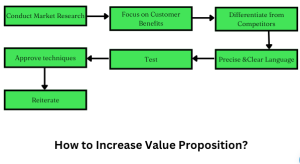
- Conduct market research: Conducting market research can help a company better understand its target customers, their needs, and what they value most in a product or service. This information can be used to refine the company’s value proposition to better meet the needs of its customers.
- Focus on customer benefits: A company’s proposition should focus on the benefits it’s product or service provides customers rather than just its features. By highlighting the value that customers will receive, a company can make its proposition more compelling.
- Differentiate from the competition: A strong proposition should highlight what differentiates a company. By identifying unique features or benefits that competitors don’t offer, a company can differentiate itself and make its proposition more attractive.
- Use precise language: It should be communicated in clear, concise language that is easy for customers to understand. Avoid using technical jargon or complex language that could confuse customers.
- Test and iterate: A company should test its value proposition with real customers and be willing to change based on their feedback. This iteration process can help a company refine over time and make it more effective.
Value Proposition for the Future
As we move towards the future, the importance of a strong proposition will only increase. Here are some key elements that can make it effective in the future:
- Sustainability: With growing concern about the environment and the impact of human activities, companies that can demonstrate a commitment to sustainability will have a strong value proposition. This could include using eco-friendly materials, reducing waste, or implementing renewable energy sources.
- Personalization: Customers increasingly expect personalised products and services tailored to their needs and preferences. Companies that can offer personalised experiences will be strong in the future.
- Technology: As technology advances, companies that can leverage it to improve their products or services will have a strong proposition. This could include using artificial intelligence, virtual reality, or other cutting-edge technologies to enhance the customer experience.
- Transparency: With the rise of social media and other forms of communication, customers expect transparency from companies. Companies that can demonstrate honesty and transparency in their operations will have a strong proposition in the future.
- Social Impact: Customers are increasingly looking for companies with a positive social impact. Companies that can demonstrate a commitment to social responsibility and giving back to the community will have a strong proposition in the future.
Ways to Create Value Proposition.
Creating a compelling proposition involves several steps:
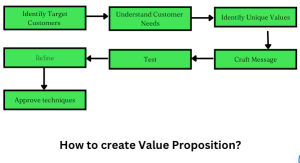
- Identify your target customer: It’s important to understand who your target customer is and what they value most in a product or service. This information can be gathered through market research, customer surveys, or customer data analysis.
- Understand customer needs: Once you have identified your target customer, it’s essential to understand their needs and pain points. This can be done through research, analysis, and conversations with customers.
- Identify your unique value: To create a strong value proposition, you must identify what sets your product or service apart from the competition. This could be a special feature, a better quality product, or a more affordable price.
- Craft your message: Once you have identified your unique value, you need to craft a clear and compelling message that communicates this value to your target customer. The letter should be simple, easy to understand, and focused on your product or service’s benefits to customers.
- Test and refine: Once you have developed it, it’s essential to test it with real customers and be willing to make changes based on their feedback. This iteration process can help you refine your proposition and make it more effective.
Example
One Indian brand example of a strong value proposition is Amul, a dairy products company. Amul’s proposition is “The Taste of India”, which communicates its commitment to producing high-quality, locally-sourced dairy products uniquely Indian.

Amul has built its value proposition on a number of key elements. Firstly, it emphasises the importance of using locally-sourced milk to support Indian farmers and ensure the freshest, highest-quality products. Secondly, it offers a wide range of dairy products that are tailored to the unique tastes and preferences of Indian consumers. Finally, Amul has built a strong reputation for quality and reliability, with its products widely recognized as some of the best in the Indian market.
By focusing on these critical elements, Amul has created a compelling value proposition that resonates with Indian consumers. Its commitment to quality, local sourcing, and uniquely Indian flavours has helped it become one of the country’s most trusted and beloved brands.
FAQ
What is a value proposition?
It is a statement that communicates the unique benefits that a product or service provides to its customers. It answers, “Why should I buy this product or service?”
Why is a value proposition important?
It is important because it helps a company differentiate itself from its competitors and communicate its unique value to customers. It can also help attract and retain customers by demonstrating how the product or service meets their needs and provides a better solution than the competition.
What are the critical elements of a strong value proposition?
A strong proposition should be clear, concise, and focused on the product or service’s benefits to customers. It should target a specific audience and address their unique needs and pain points. It should also be differentiated from the competition and communicate an outstanding value that sets it apart.
How can I create a value proposition for my product or service?
To create a value proposition, you must identify your target customer, understand their needs and pain points, and place your unique value proposition. You can then craft a clear and compelling message that communicates this value to your target audience.
How can I test the effectiveness of my value proposition?
You can test your proposition’s effectiveness by getting customer feedback through surveys, focus groups, or by analysing customer behaviour and engagement. You can then use this feedback to refine your value proposition and make it more effective.
UTM Parameters
UTM Parameters
Definition
UTM parameters are tags added to URLs to track and analyse website traffic and campaign performance.
Description
These are essential for businesses to track and analyse the effectiveness of their marketing campaigns. By adding UTM tags to URLs, businesses can identify the source, medium, and specific campaign that led a user to their website, track paid keywords and differentiate between different versions of ads.
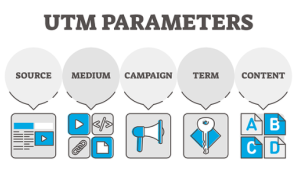
This data is captured by Google Analytics and displayed in the Campaigns section, allowing businesses to make data-driven decisions and optimise their marketing strategies. With these, it can be easier to accurately measure the success of marketing campaigns and make informed decisions for future efforts.
Importance of UTM Parameters
UTM parameters are important because:
- They allow businesses to track and analyse the effectiveness of their marketing campaigns.
- By adding UTM tags to URLs, businesses can identify the source, medium, and specific campaign that led a user to their website, track paid keywords and differentiate between different versions of ads. This data is captured by Google Analytics and displayed in the Campaigns section, allowing businesses to make data-driven decisions and optimise their marketing strategies.
- Without these, it can be difficult to accurately measure the success of marketing campaigns and make informed decisions for future efforts.
- These provide businesses with valuable insights into the behaviour and preferences of their target audience, allowing them to optimise their marketing strategies and ultimately increase conversions and revenue.
Components of UTM Parameters
UTM parameters consist of five components:
- Campaign Source (utm_source): This parameter identifies the traffic source, such as a search engine or social media platform.
- Campaign Medium (utm_medium): This parameter identifies the medium of the traffic, such as email, social media, or referral.
- Campaign Name (utm_campaign): This parameter identifies the specific campaign or promotion, such as a holiday sale or product launch.
- Campaign Term (utm_term): This parameter tracks paid keywords in advertising campaigns.
- Campaign Content (utm_content): This parameter is used to differentiate between different versions of the same ad, such as different images or calls-to-action.
When a user clicks on a URL with UTM parameters, the data is captured by Google Analytics and displayed in the Campaigns section of the platform. This allows businesses to track the effectiveness of their marketing campaigns and make data-driven decisions to optimise their strategies.
How to Use UTM Parameters to Track Social Media Success?
Using it to track social media success is a simple process that can provide valuable insights into the effectiveness of your social media campaigns. Here are the steps to follow:
- Choose the UTM parameters you want to use: Decide on the source, medium, campaign name, and other parameters you want to track for your social media campaign.
- Create your unique UTM URLs: Use a UTM builder tool, such as Google’s Campaign URL Builder, to create unique URLs for each social media post or ad.
- Share the UTM URLs on social media: Share the UTM URLs on your social media channels like Facebook, Twitter, LinkedIn, or Instagram.
- Monitor and analyse the UTM data: Monitor the traffic and conversions generated from the URLs in Google Analytics. Use the Campaigns report to track the performance of your social media campaigns, identify the best-performing platforms and campaigns, and make data-driven decisions to optimise your social media strategy.
Future aspects of UTM Parameters
The future of it will likely see continued growth in their use and importance for businesses of all sizes. As digital marketing continues to evolve, businesses must leverage data-driven insights to stay ahead of the competition. It provide a simple yet powerful way to track the effectiveness of marketing campaigns.
Some potential future developments for UTM parameters may include:
- Increased use of automation: Automation tools may be developed to help businesses streamline the process of creating and tracking it, making it easier for even small businesses to take advantage of this powerful tool.
- Integration with more platforms: As social media and other digital platforms continue to emerge, there may be more opportunities for UTM parameters to be integrated into these platforms, providing even more data for businesses to analyse.
- Better attribution modelling: Attribution modelling assigns credit to different marketing channels for generating conversions, and it can help in this process. As attribution modelling continues to evolve, it may play an even more significant role in assisting businesses to accurately measure their marketing efforts’ impact.
Example
In this example, the UTM parameters are:
- utm_source=facebook: This parameter identifies the source of the traffic as Facebook.
- utm_medium=social: This parameter identifies the medium of the traffic as social media.
- utm_campaign=spring_sale: This parameter identifies the campaign as the spring sale.
- utm_content=ad1: This parameter identifies the specific ad as ad1.
When a user clicks on this URL and visits the website, Google Analytics will capture the UTM data and display it in the Campaigns report. This allows businesses to see how much traffic and conversions were generated from this specific social media ad and use that data to optimise their marketing campaigns.
FAQ
What are UTM parameters, and why are they important?
These are tags added to the end of a URL to track the effectiveness of online marketing campaigns. They are important because they allow businesses to see which campaigns generate traffic and conversions and which are not.
How do I create UTM parameters?
It can be created using Google’s Campaign URL Builder tool. Simply enter the URL of the page you want to link to and add the appropriate UTM parameters for source, medium, campaign, and content.
How do I track UTM parameters in Google Analytics?
To track UTM parameters in Google Analytics, navigate to the Acquisition > Campaigns > All Campaigns report. This report will show how much traffic and conversions were generated from each UTM parameter.
Can UTM parameters be used for offline marketing campaigns?
Yes, it can be used for offline marketing campaigns as well. For example, businesses could include a UTM parameter in a print ad or direct mail piece to track how much traffic and conversions were generated from that campaign.
What are some best practices for using UTM parameters?
Some best practices for using UTM parameters include: being consistent in your naming conventions, avoiding using too many parameters in a single URL, and using it to test different variations of your marketing campaigns. It’s also important to ensure you track UTM parameters in Google Analytics and use that data to optimise your campaigns.


